
Bandini is a 1963 Hindi drama film directed and produced by Bimal Roy.It stars Nutan, Ashok Kumar and Dharmendra. The film tells the story of a woman prisoner serving life imprisonment for murder, Kalyani, the all suffering, selfless, sacrificing and strong, yet weak Indian woman. She must make a choice between two very different men, Devendra (Dharmendra), the loving prison doctor, and Bikash, a man from her past.
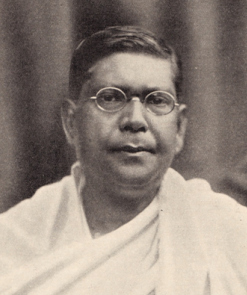
Chittaranjan Das, popularly called Deshbandhu, was an Indian freedom fighter, political activist and lawyer during the Indian Independence Movement and the Political Guru of Indian freedom fighter Netaji Subhas Chandra Bose. He is the founder-leader of the Swaraj Party in undivided Bengal during the period of British Colonial rule in India. His name is abbreviated as C. R. Das. He was closely associated with a number of literary societies and wrote poems, apart from numerous articles and essays.

The Cellular Jail, also known as 'Kālā Pānī', was a British colonial prison in the Andaman and Nicobar Islands. The prison was used by the colonial government of India for the purpose of exiling criminals and political prisoners. Many notable independence activists, including Sardar Singh Artillery, Diwan Singh Kalepani, Yogendra Shukla, Batukeshwar Dutt, Shadan Chandra Chatterjee, Sohan Singh, Vinayak Savarkar, Hare Krishna Konar, Shiv Verma, Allama Fazl-e-Haq Khairabadi, and Sudhanshu Dasgupta were imprisoned here during the struggle for India's independence. Today, the complex serves as a national memorial monument.
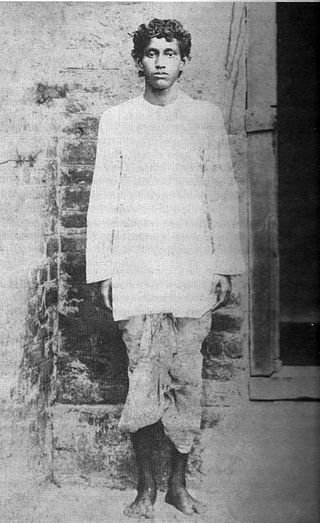
Khudiram Bose was an Indian nationalist from Bengal Presidency who opposed British rule of India. For his role in the Muzaffarpur Conspiracy Case, along with Prafulla Chaki, he was sentenced to Khudiram, along with Prafulla Chaki, attempted to assassinate a British judge, Magistrate Douglas Kingsford, by throwing bombs on the carriage they suspected the man was in. Magistrate Kingsford, however, was seated in a different carriage, and the throwing of bombs resulted in the deaths of two British women. Prafulla fatally shot himself before the arrest. Khudiram was arrested and trialed for the murder of the two women, ultimately being sentenced to death. He was one of the first Indian revolutionaries in Bengal to be executed by the British.
Emperor v Aurobindo Ghosh and others, colloquially referred to as the Alipore Bomb Case, the Muraripukur conspiracy, or the Manicktolla bomb conspiracy, was a criminal case held in India in 1908. The case saw the trial of a number of Indian nationalists of the Anushilan Samiti in Calcutta, under charges of "Waging war against the Government" of the British Raj. The trial was held at Alipore Sessions Court, Calcutta, between May 1908 and May 1909. The trial followed in the wake of the attempt on the life of Presidency Magistrate Douglas Kingsford in Muzaffarpur by Bengali nationalists Khudiram Bose and Prafulla Chaki in April 1908, which was recognised by the Bengal police as linked to attacks against the Raj in the preceding years, including attempts to derail the train carrying Lieutenant-Governor Sir Andrew Fraser in December 1907.

Anushilan Samiti was an Indian fitness club, which was actually used as an underground society for anti-British revolutionaries. In the first quarter of the 20th century it supported revolutionary violence as the means for ending British rule in India. The organisation arose from a conglomeration of local youth groups and gyms (akhara) in Bengal in 1902. It had two prominent, somewhat independent, arms in East and West Bengal, Dhaka Anushilan Samiti, and the Jugantar group.

Dinesh Chandra Gupta or Dinesh Gupta was an Indian revolutionary against British rule in India, who is noted for launching an attack on the Secretariat Building - the Writers' Building in the Dalhousie square in Calcutta, along with Badal Gupta and Benoy Basu.

Badal Gupta, real name Sudhir Gupta, was an Indian revolutionary against British rule in India, who is noted for launching an attack on the Secretariat Building - the Writers' Building in the Dalhousie square in Calcutta, along with Benoy Basu and Dinesh Gupta.
The Revolutionary movement for Indian Independence was part of the Indian independence movement comprising the actions of violent underground revolutionary factions. Groups believing in armed revolution against the ruling British fall into this category, as opposed to the generally peaceful civil disobedience movement spearheaded by Mahatma Gandhi.
Jugantar or Yugantar was one of the two main secret revolutionary trends operating in Bengal for Indian independence. This association, like Anushilan Samiti, started in the guise of a suburban health and fitness club while secretly nurturing revolutionaries. Several Jugantar members were arrested, hanged, or deported for life to the Cellular Jail in Andaman and many of them joined the Communist Consolidation in the Cellular Jail.
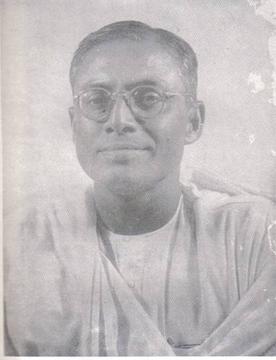
Bhupendra Kumar Dutta was an Indian freedom fighter and a revolutionary who fought for Indian independence from British rule. In addition to his other specific contributions as a Jugantar leader, he holds the record of a hunger strike for 78 days in Bilaspur Jail in December 1917.
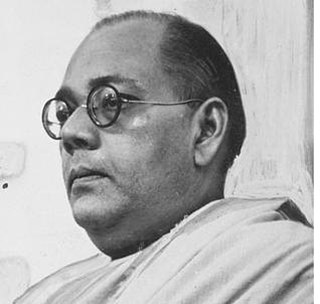
Sarat Chandra Bose was an Indian barrister and independence activist.

Panchanan Chakravarti was a Bengali Indian revolutionary, one of the creators of the Revolt group after the momentary unification of the Anushilan Samiti and the Jugantar in the 1920s. Friend of the poet Kazi Nazrul Islam, he was a close associate of Subhas Chandra Bose.

Kanailal Dutta was an Indian nationalist involved in the Indian Independence Movement belonging to the Jugantar group. He was born in Chandannagar, West Bengal. He, along with Satyendranath Bose, was convicted by the British for the assassination of Narendranath Goswami, an approver of the British, in the Jail hospital of Alipore Central Jail on 31 August 1908. Satyendranath Bose was hanged till death on 21 November 1908.
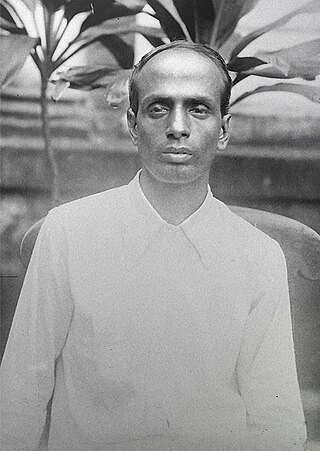
Surya Sen, also known as Surya Kumar Sen, was an Indian revolutionary who was influential in the independence movement against British rule in India and is best known for leading the 1930 Chittagong armoury raid.

Hemanta Kumar Sarkar was an Indian philologist, author, biographer, editor, publisher, union leader, leader of the Indian freedom movement and an associate of Subhas Chandra Bose. He was a close friend and the first biographer of Subhas Chandra Bose, the co-founder of Labour Swaraj Party in Bengal along with Muzaffar Ahmed and Kazi Nazrul Islam and led the movement for the Partition of Bengal and formation of Bengali Hindu homeland in 1947.

Satyendra Nath Bosu was an Indian nationalist of the Anushilan Samiti. Bosu, while held in Alipore Jail hospital as an under-trial in the Alipore Bomb Case, shot dead the Crown witness Narendranath Goswami with the help of fellow prisoner Kanailal Dutta, leading to the collapse of the case against prime suspect Aurobindo. Bosu gave himself up on the jail premises and was subsequently put on trial. Along with Dutta, he was found guilty and executed by hanging on 21 November 1908 for the murder of Goswami.

Shrish Chandra Ghosh was a Bengali revolutionary and Indian independence activist.

Ramkrishna Biswas was an Indian revolutionary and martyr. He was an active member of Surya Sen's revolutionary group.

Charu Chandra Bose was an Indian revolutionary and member of the Anushilan Samiti who carried out assassinations against British colonial officials in an attempt to secure Indian independence. He was hanged on 19 March 1909 for the charge of assassination of Ashutosh Biswas a notorious Public Prosecutor who was responsible for the conviction of many revolutionaries in the Muraripukur Bomb case and many other false cases shortly after the Anti-Partition Movement.


















